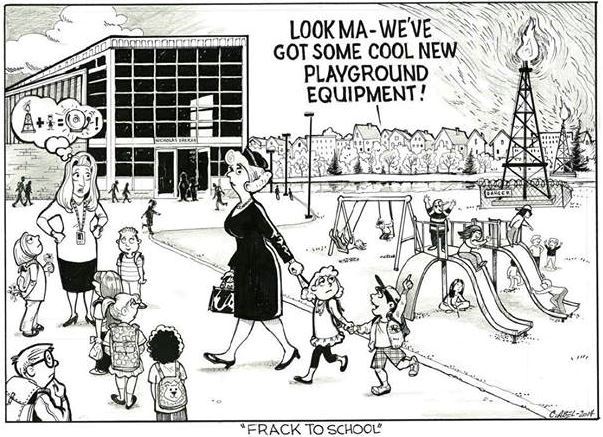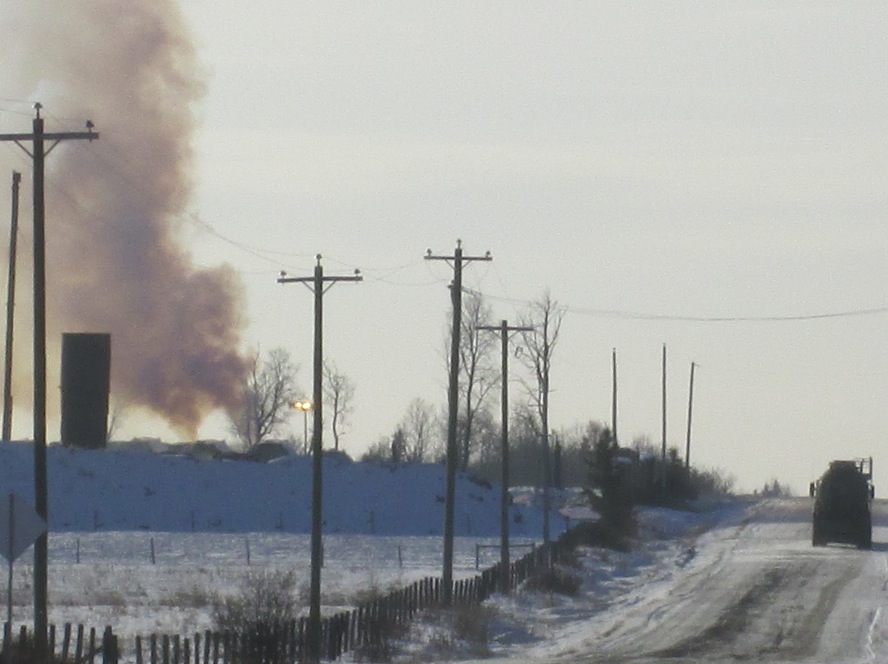Refer first to:
2016 10 25: Yale School of Public Health: Fracking Linked to Cancer-Causing Chemicals

Cochrane Interpipeline Gas Plant NW of Calgary, Alberta

Fracking by your school?
Unconventional oil and gas by your home?
Hold your breath, all day and night long:




Frac photos by FrackingCanada

2015: Encana deadly sour gas well blowout, west of the town of Fox Creek, Alberta.

Air pollutants make a case for walking ver-r-ry slowly, study finds by Tom Spears, October 28, 2016, Ottawa Citizen
Speed kills, according to a new University of British Columbia study on how much pollution we inhale when we walk or cycle quickly.
Or more precisely, speed makes us breathe in more toxic stuff.
Alex Bigazzi studies transportation at UBC, and has previously studied how much air pollution cyclists inhale on streets with heavy traffic compared to light traffic. (Short version: Their lungs contain 40 to 100 per cent more hydrocarbons on the busy streets.) [What about adding deadly drill, cementing, fracing and servicing chemicals to the mix? No more gardening, biking, skating, skipping, working, walking, running, playing at home, on farms, local businesses and in communities with oil and gas well sites, associated facilities spewing pollutants? Definitely no hill walking or running?]
Now he asks a second, more general question: What’s the optimum speed for walking and cycling without choking on fumes? [Never mind optimum. What’s the safe level of ordinary breathing near oil and gas well sites and associated facilities? Does any oil company or regulator anywhere in the world give a damn?]
Depends a little on your age and to a lesser extent on gender, he found, but it’s safe to say these speeds won’t require Spandex clothes.
Men aged 20 to 60 should cycle at 14.5 km/h and women aged 20 to 60 a bit more slowly, 13.1 km/h, he found. Those under 20 should be travelling a bit more slowly — 13.4 km/h for men, 12.5 km/h for women. (All the figures are for flat terrain.)
But walking is the big surprise in his analysis.
He wants anyone under the age of 20 to protect their lungs by limiting their speed to a lethargic 3.4 km/h. That’s 2.1 miles an hour, for those who measure that way. At that speed, your kids are going to be late for school a lot. [What about children living or going to school beside drilling and fracing, gas plants, tank farms, compressor stations? Walk, play and live Slowly, No running, skipping in the playground and no more physical education?]
You can speed up a little after age 20, but not much, he suggests: He still suggests men and women all ages to stay below 5 km/h.
His study is published in the International Journal of Sustainable Transportation. [Emphasis added]
Breath Biomarkers to Measure Uptake of Volatile Organic Compounds by Bicyclists by Alexander Y. Bigazzi, Miguel A. Figliozzi, Wentai Luo, and James F. Pankow, Environ. Sci. Technol., 2016, 50 (10), pp 5357–5363, April 20, 2016
DOI: 10.1021/acs.est.6b01159, 2016 American Chemical Society
Breath biomarkers were used to study uptake of traffic-related volatile organic compounds (VOCs) from urban bicycling. Breath analysis was selected because it is one of the least invasive methods to assess urban traveler exposure. Research hurdles that were overcome included considering that factors other than on-road exposure can influence concentrations in the body, and absorbed doses during a trip can be small compared to baseline body burdens. Pre-trip, on-road, and post-trip breath concentrations and ambient air concentrations were determined for 26 VOCs for bicyclists traveling on different path types. Statistical analyses of the concentration data identified eight monoaromatic hydrocarbons potentially useful as breath biomarkers to compare differences in body levels brought about by urban travel choices. Breath concentrations of the biomarker compounds were significantly higher than background levels after riding on high-traffic arterial streets and on a path through a high-exposure industrial area, but not after riding on low-traffic local streets or on other off-street paths. Modeled effects of high-traffic streets on ambient concentrations were 100–200% larger than those of low-traffic streets; modeled effects of high-traffic streets on breath concentrations were 40–100% larger than those of low-traffic streets. Similar percentage increases in breath concentrations are expected for bicyclists in other cities.


